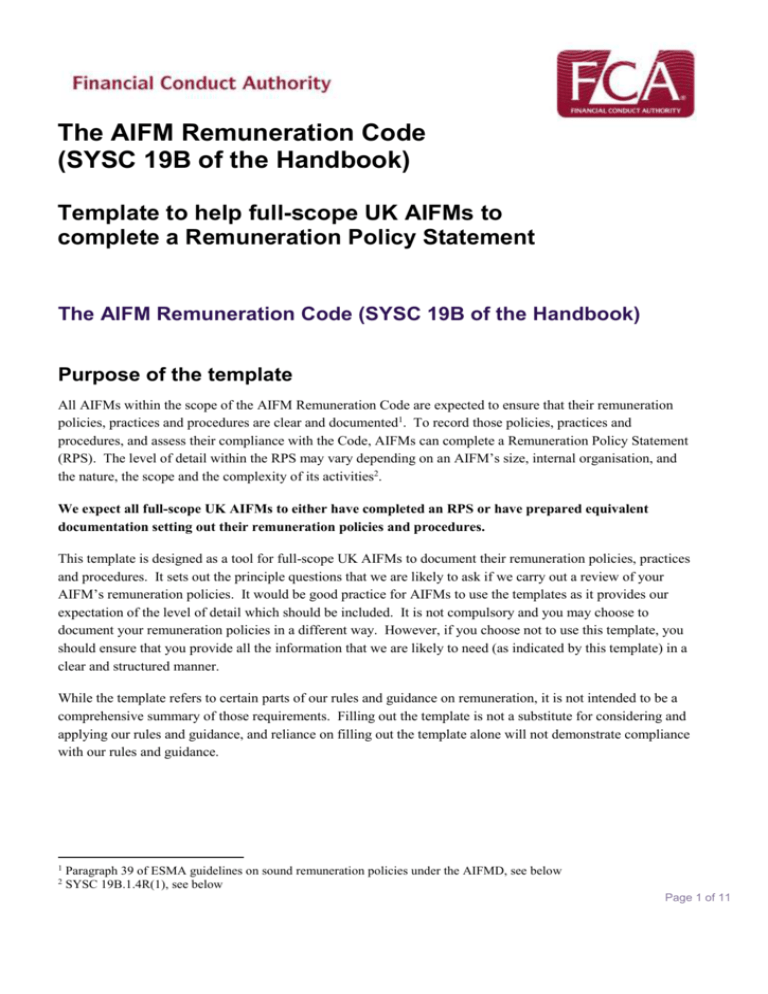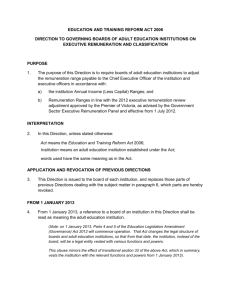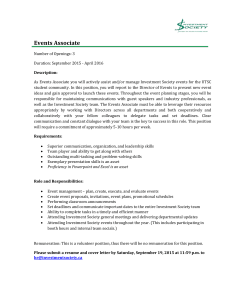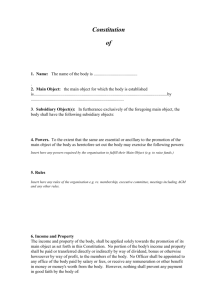The AIFM Remuneration Code
advertisement

The AIFM Remuneration Code (SYSC 19B of the Handbook) Template to help full-scope UK AIFMs to complete a Remuneration Policy Statement The AIFM Remuneration Code (SYSC 19B of the Handbook) Purpose of the template All AIFMs within the scope of the AIFM Remuneration Code are expected to ensure that their remuneration policies, practices and procedures are clear and documented1. To record those policies, practices and procedures, and assess their compliance with the Code, AIFMs can complete a Remuneration Policy Statement (RPS). The level of detail within the RPS may vary depending on an AIFM’s size, internal organisation, and the nature, the scope and the complexity of its activities2. We expect all full-scope UK AIFMs to either have completed an RPS or have prepared equivalent documentation setting out their remuneration policies and procedures. This template is designed as a tool for full-scope UK AIFMs to document their remuneration policies, practices and procedures. It sets out the principle questions that we are likely to ask if we carry out a review of your AIFM’s remuneration policies. It would be good practice for AIFMs to use the templates as it provides our expectation of the level of detail which should be included. It is not compulsory and you may choose to document your remuneration policies in a different way. However, if you choose not to use this template, you should ensure that you provide all the information that we are likely to need (as indicated by this template) in a clear and structured manner. While the template refers to certain parts of our rules and guidance on remuneration, it is not intended to be a comprehensive summary of those requirements. Filling out the template is not a substitute for considering and applying our rules and guidance, and reliance on filling out the template alone will not demonstrate compliance with our rules and guidance. 1 2 Paragraph 39 of ESMA guidelines on sound remuneration policies under the AIFMD, see below SYSC 19B.1.4R(1), see below Page 1 of 11 Remuneration Policy Statement template for full-scope UK AIFMs Background You do not need to send us a copy of your RPS or equivalent documentation of your policy and procedures unless requested to do so. However, this should be reviewed and approved by the AIFM’s Remuneration Committee or equivalent body with responsibility for remuneration policies. Completing your RPS Scope of the Code Where your AIFM is part of a group that contains more than one AIFM and you have adopted group-wide policies, you may wish to use the RPS template to document all full-scope UK AIFMs, noting any differences in treatment between them. Where your AIFM is part of a group that primarily falls into the Dual-Regulated firms Remuneration Code, IFPRU Code & BIPRU Code, you may wish to use this as an annex to note any differences from your groupwide template. Proportionality framework The proportionality principle (SYSC 19B.1.4R(1)) requires AIFMs to comply with the Code’s requirements ‘in a way and to the extent that is appropriate to its size, internal organisation and the nature, the scope and the complexity of its activities’. Guidance on the proportionate application of the Code is provided in the provisions of SYSC 19B and in our General Guidance on the AIFM Remuneration Code (SYSC 19B); the latter sets out a proportionality framework that is designed to implement the Code proportionately and consistently. It provides a starting point to help AIFMs understand which rules are likely to apply to them in full and which ones normally apply only to AIFMs in the higher levels in full. Further guidance on proportionality is provided in the ESMA guidelines on sound remuneration policies under the AIFMD. Annexes The RPS Tables form part of your RPS. This RPS has an Excel spread sheet template to record your AIFM Remuneration Code staff, remuneration structures and any guaranteed variable remuneration awarded to AIFM Remuneration Code staff. If you decide to use this template then you can also complete the RPS Tables for the current performance year. Page 2 of 11 Remuneration Policy Statement template for full-scope UK AIFMs A. AIFM Specific Information A.i Please list all of the AIFMs within your group that are caught by the Code. AIFM Name A.ii FRN Business Type No. of AIFM Remuneration Code Staff Type of AIFM3 (Delete as applicable) # 1/2 Provide contact details of the key individual(s) who we should contact within your AIFM regarding your AIFM’s compliance with the AIFM Remuneration Code. Name Job Title Phone No. A.iii What dates does your performance year run from/to: A.iv What performance year is this RPS in respect of: B. Remuneration Schemes Email Please refer, in particular, to SYSC 19B.1.21R (Remuneration Principle 6: Measurement of performance) and SYSC 19B.1.12R to SYSC 19B.1.20G (Remuneration 5: Remuneration structures). Please also refer to Part 3 of ’General Guidance on the AIFM Remuneration Code (SYSC 19B)’ on the circumstances where certain principles of the Remuneration Code may be disapplied, published on the FCA’s website. B.i 3 List all bonus schemes or other reward or compensation schemes (including those in place for partnerships and other legal structures) that will be in place to reward AIFM Remuneration Code Staff for performance during the current performance year and provide a high-level description of each scheme, including: the scheme’s purpose; intended participants; number of expected participants for the current performance year; the structure of each scheme’s awards, including: o determination of the deferred proportion; o the length of the vesting period o the vesting schedule including whether vesting is on a pro-rata basis; cliff vesting at the end of the performance period or any other combination; o award composition i.e. proportion in shares/cash etc. if appropriate (AIFMs may be able to demonstrate that it is inappropriate for them to use alternative instruments to shares. Individual guidance should generally be sought); o retention policies applied to any part of the awards; and o the length of the retention policy the ratio of the maximum payout of the bonus scheme when compared to fixed remuneration; the performance measures and the risk adjustment used to determine whether the scheme will Refer to Table 2 in ‘General Guidance on the AIFM Remuneration Code (SYSC 19B)’ Page 3 of 11 Remuneration Policy Statement template for full-scope UK AIFMs pay out and how much; the proportion of the deferred portion that is subject to performance adjustment; and any other information related to the scheme that you believe is relevant. Note: Where this information is provided clearly under Principle 5 of this template, there is no need to duplicate this here. a) b) B.ii Bonus scheme 1 Bonus scheme 2 Please list all existing executive incentive schemes (e.g. Long Term Incentive Plans (LTIPs)) that could incentivise AIFM Remuneration Code Staff for future performance and provide a highlevel description of each scheme, including: the scheme’s purpose; whether each scheme has been approved by the AIFM’s owners; intended participants and the number of people currently participating in the scheme, including how many are AIFM Remuneration Code Staff for the current performance year; the ratio of the maximum payout of the LTIP award when compared to fixed remuneration especially when used in conjunction with other forms of variable remuneration; the structure of the scheme’s awards, including a description of the initial award (e.g. deferred cash, shares, share options, phantom shares) and the form of the proposed payout (e.g. proportion in shares, cash etc); the Estimated Value (EV) of the scheme at the time of the initial award; the length of the scheme’s performance period and whether a new performance period starts each year, overlapping the previous performance period; or whether the performance periods run end to end; o the length of the vesting period; o the vesting schedule whether vesting is on a pro-rata basis; cliff vesting at the end of the performance period or any other combination; and o the length of the retention policy; the performance measures and the risk adjustment used to determine whether and how much the scheme will pay out if appropriate; when the scheme is due for review; and any other information related to the scheme that you believe is relevant. Note: Where this information is clearly set out elsewhere, you may wish to refer directly to this and include a copy as an annex. a) b) C. Executive Incentive scheme 1 Executive Incentive scheme 2 AIFM Remuneration Code Staff It is up to each AIFM to determine how they identify their AIFM Remuneration Code Staff; as a starting point Page 4 of 11 Remuneration Policy Statement template for full-scope UK AIFMs you should include senior management, risk takers, staff engaged in control functions and any employees receiving total remuneration that takes them into the same remuneration bracket as senior management and risk takers. (SYSC 19B.1.3R) with reference to relevant ESMA guidelines. C.i Please set out the high level framework you have used to determine which of your staff are ‘AIFM Remuneration Code Staff’ C.ii How many AIFM Remuneration Code Staff have been identified? C.iii List all AIFM Remuneration Code Staff using the RPS Tables spread sheet C.iv How many AIFM Remuneration Code Staff are likely to rely on the guidance set out in SYSC 19B.1.13A G (and further developed in General Guidance on the AIFM Remuneration Code (SYSC 19B)? C.v Briefly describe the measures you have taken to ensure that all AIFM Remuneration Code Staff understand the implications of this status in relation to the requirements of the Code. C.vi How have you been able to determine how to identify your delegates and how many have been identified? 1. Principle 1 – Risk management Please refer to SYSC 19B.1.5R 1.1 Briefly describe how you ensure that your AIFM’s remuneration policies and practices promote sound and effective risk management, and do not encourage risk-taking which is inconsistent with the risk profile of the instrument constituting the fund of the AIFs it manages. 2. Principle 2 – Supporting business strategy, objectives, values and interests, and avoiding conflicts of interest Please refer to SYSC 19B.1.6R 2.1 Briefly describe how your AIFM ensures that its remuneration policies are in line with the business strategy, objectives, values and interests they have alongside the AIFs they manage or the investors of such AIFs, and includes measures to avoid conflicts of interest. Page 5 of 11 Remuneration Policy Statement template for full-scope UK AIFMs 3. Principle 3 – Governance Please refer to SYSC 19B.1.7R to SYSC 19B.1.9R and ‘General Guidance on the AIFM Remuneration Code (SYSC 19B)’, published on our website. Please also refer to Part 3 of ’General Guidance on the AIFM Remuneration Code (SYSC 19B)’ which sets out the circumstances under which an AIFM may be able to justify not establishing a remuneration committee. 3.1 3.2 Does your AIFM have a Remuneration Committee (RemCo) established within the UK? Yes / No (Delete as applicable) Describe how remuneration governance arrangements operate within your AIFM including: The name of the RemCo if known by any other name whether there are any sub-committees of the RemCo, what they are called and what their purpose is; If your AIFM doesn’t have a RemCo established in the UK, who makes remuneration decisions for the AIFM (please refer to ‘Application of Proportionality’ under Principle 5); How information is shared between committees such as the Risk and Audit Committees Whether the RemCo has appointed remuneration consultants for advice and How the AIFM can ensure that the implementation of the remuneration policy is, at least annually, subject to central and independent internal review for compliance with policies and procedures for remuneration 3.3 How does your AIFM ensure that remuneration decisions take into account the implications for risk and risk management of the AIFM? 3.4 Does the RemCo/ equivalent governing body have the ability to apply discretion to adjust the bonus pool and individual payments including those paid out in individual incentive schemes? 3.5 Has the RemCo / equivalent governing body ever exercised that discretion? If so, when and in what circumstances? 4. Principle 4 – Control functions Please refer to SYSC 19B.1.10R to SYSC 19B.1.11R and the AIFMD Level 2 requirements relating to the payment Page 6 of 11 Remuneration Policy Statement template for full-scope UK AIFMs of persons engaged in risk management (as set out in FUND 3.7.3 EU) 4.1 With regard to employees engaged in control functions, briefly explain how you ensure that these employees are remunerated in accordance with the achievement of objectives linked to their functions, independent of the performance of the business areas they control. 4.2 Who oversees the remuneration of senior officers in the risk management and compliance functions? 5. Principle 5 – Remuneration Structures Remuneration Principle 5 consists of a series of rules, evidential provisions and guidance relating to remuneration structures. Please refer to SYSC 19B.1.12R to SYSC 19B.1.20G. Please also refer to Part 3 of ’General Guidance on the AIFM Remuneration Code (SYSC 19B)’ on the circumstances where certain principles of the Remuneration Code may be disapplied, published on the FCA’s website. Application to Proportionality 5.1 Where your AIFM wishes to rely on the Principle of Proportionality to disapply any of the payout rules in this section, please provide your rationale for why you believe this to be appropriate in line with Section 5 of the ‘General Guidance on the AIFM Remuneration Code (SYSC 19B)’. Assessment of Performance Please refer to SYSC 19B.1.12R to SYSC 19B.1.13A G 5.2 Please set out a high-level description of your AIFM’s approach to measuring the performance of individuals including both financial and non-financial metrics and explain how this assessment influences an individual’s remuneration. Guaranteed variable remuneration Please refer to SYSC 19B.1.14R 5.3 Please outline circumstances in which your AIFM may offer guaranteed variable remuneration awards, including how they meet the requirements of the Remuneration Code. i) Sign-on ii) Buyouts iii) Retention Fixed and Variable components of total remuneration Page 7 of 11 Remuneration Policy Statement template for full-scope UK AIFMs Please refer to SYSC 19B.1.15R 5.4 How do you ensure that the fixed and variable components are appropriately balanced, with the fixed component representing a sufficiently high proportion of total remuneration allow the operation of a fully flexible policy on variable remuneration components? Payments related to early termination Please refer to SYSC 19B.1.16R 5.5 Have you ensured that any early termination payments to staff in the current performance year have been compliant with the Code? Yes / No (Delete as applicable) Retained units, shares or other instruments Please refer to SYSC 19B.1.17R Please also refer to Part 3 of ’General Guidance on the AIFM Remuneration Code (SYSC 19B)’ on the circumstances where certain principles of the Remuneration Code may be disapplied, published on the FCA’s website. 5.6 Briefly describe the instruments that you use to comply with SYSC 19B.1.17R. 5.7 Describe the composition of your variable remuneration awards between cash / shares and other non-cash instruments and how this split is applied to both the up-front and the deferred elements of those awards. 5.8 Describe how the retention policy in SYSC 19B.1.17R(2) is applied to the above instruments and how this is designed to align with the longer-term interests of the AIFM, the AIFs it manages and the investors of such AIFs. Deferral Page 8 of 11 Remuneration Policy Statement template for full-scope UK AIFMs Please refer to SYSC 19B.1.18R to SYSC 19B.1.18A G Please also refer to Part 3 of ’General Guidance on the AIFM Remuneration Code (SYSC 19B)’ on the circumstances where certain principles of the Remuneration Code may be disapplied, published on the FCA’s website. 5.9 Deferral arrangements for AIFM Remuneration Code Staff If AIFM Remuneration Code Staff participate in different schemes, please answer these questions for each of the schemes they participate in. What is the length of vesting for AIFM Remuneration Code Staff? How is vesting structured? Please provide detail on the vesting schedule including whether vesting occurs on a cliff vesting; pro-rata basis; a combination of both or whether it varies by different schemes. Whether this is an AIFM-wide or group-wide policy. What percentage of variable remuneration is deferring? Performance Adjustment (Ex-Post Risk Adjustment) Please refer to SYSC 19B.1.19R to 19B.1.20G. Please also refer to Part 3 of ’General Guidance on the AIFM Remuneration Code (SYSC 19B)’ on the circumstances where certain principles of the AIFM Remuneration Code may be disapplied, published on the FCA’s website. 5.10 Please outline your policy on performance adjustment. This should include the following: Whether this is a AIFM-wide or group-wide policy; How this meets the Code’s requirements for total variable remuneration to be subject to expost risk adjustment including current year awards and through malus The criteria for the application of ex-post risk adjustment, including whether you are able to clawback vested awards; How this policy is applied at a AIFM level; business unit level and at an individual level; and How much of the unvested award can be forfeited? Please also include any other relevant information concerning implementation and operation of the policy. 5.11 Please provide detail on what situations may trigger the use of ex-post risk adjustment. If your performance adjustment clauses have been triggered previously, please provide real examples. Otherwise, please detail the type of situation where performance adjustment would be considered at an individual level or collectively. 5.12 Please outline the process for deciding cases that can result in the use of ex-post risk adjustment. This should include which roles, departments, functions and committees are responsible for reporting information, the escalation and decision making processes. Please also detail how control functions provide information and contribute to discussions as required. Page 9 of 11 Remuneration Policy Statement template for full-scope UK AIFMs 6. Principle 6 – Measurement of Performance Please refer to SYSC 19B.1.21R Bonus schemes that reward AIFM Remuneration Code Staff Scheme name 6.1 6.2 Provide a high-level summary of how you determine the overall bonus pool amount (i.e. the total value of all pools of variable remuneration), including whether it involves a top-down and/or bottom up process (if appropriate). a) Please describe what key performance measures are used to determine the bonus pool and the overall weighting of these measures. b) Provide a high level summary of how these key performance measurements are risk-adjusted (e.g. use of a pre-agreed numerical formula or other factors) 6.3 6.4 7. Are any discretionary factors applied to adjust the bonus pool for risk? Please include: the stages of the process when such discretion can be applied; the items to which discretion can be applied; the bodies or individuals who may exercise that discretion, and the boundaries/parameters used on these discretionary elements. How does your bonus pool determination process take account of situations where the AIFM’s performance is weak or loss-making? Principle 7 – Pension policy Please refer to SYSC 19B.1.22R 7.1 Do you have a policy for discretionary pension benefits? Yes / No (Delete as applicable) Page 10 of 11 Remuneration Policy Statement template for full-scope UK AIFMs 7.2 If your answer to question 7.1 is ‘Yes’, please outline how your policy is in line with business strategy, objectives, values and long-term interests of the AIF you manage. 7.3 Please advise the retention period and the instruments used for any discretionary pension payments. 7.4 Do you utilise discretionary payment benefits? 8. Principle 8 – Personal investment strategies Please refer to SYSC 19B.1.23R 8.1 What arrangements do you have in place to ensure that your employees undertake not to use personal hedging strategies or remuneration or liability-related insurance to undermine the risk alignment effects embedded in their remuneration arrangements? 9. Principle 9 – Avoidance of the Remuneration Code Please refer to SYSC 19B.1.24R 9.1 How do you ensure that variable remuneration is not paid through vehicles or methods that facilitate the avoidance of the requirements of the AIFM Remuneration Code? 10. Other 10.1 If necessary, please provide further evidence of how your remuneration policies, procedures and practices are consistent with and promote sound and effective risk management? Page 11 of 11





